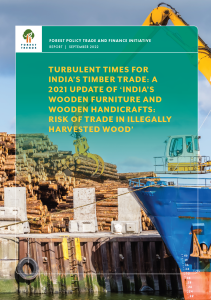Turbulent Times For India’s Timber Trade
A 2021 Update of "India's Wooden Furniture and Wooden Handicrafts: Risk of Trade in Illegally Harvested Wood"
By Michael Richards, Sofia Tenorio Fenton, Naomi Basik Treanor, and Kerstin Canby View PublicationThis report focuses on recent changes in India’s international timber trade, especially over the 2019–2021 period, and the implications (of identified changes) for India’s sourcing of illegally harvested or traded timber. The paper thus provides an update of Forest Trends’ 2020 report India’s wooden furniture and wooden handicrafts: risk of trade in Illegally harvested wood (Norman & Canby 2020).
The findings of the 2020 Forest Trends’ report as regards to the long-term timber illegality risk profile of India’s timber trade remain valid. Although the illegality risk level of India’s timber imports has been lower over the 2019–2021 period than the preceding years, this is almost certainly due to COVID, and therefore short-term. In the absence of timber import regulations, the pre-COVID risk levels will probably be reestablished when India’s domestic demand picks up this is projected to rise fast through the 2020s.
The probable explanatory factors for the overall fall in India’s timber imports from high-risk sources over the 2019 to 2021 period are:
- A drop (probably temporary) in domestic consumption of some high-risk imported species.
- Supply-chain disruption from a number of high-risk sources, where in general, imports were up from higher income countries that were able to advance faster with their vaccination. programs and bring COVID under control.
- Increased substitution of high-risk imports by domestic production, despite noted lack of elasticity of domestic timber supply.
- COVID outbreaks in source countries, which continued to impact India’s timber supply chain in 2021.
We are therefore probably observing a short-term trend. The long-term trend will only become clear once data from 2022 and beyond becomes available. However, we expect that short-term factors including remaining COVID-related impacts, the war in Ukraine and a sharp rise in inflation will likely influence India’s timber trade for oncoming years.

